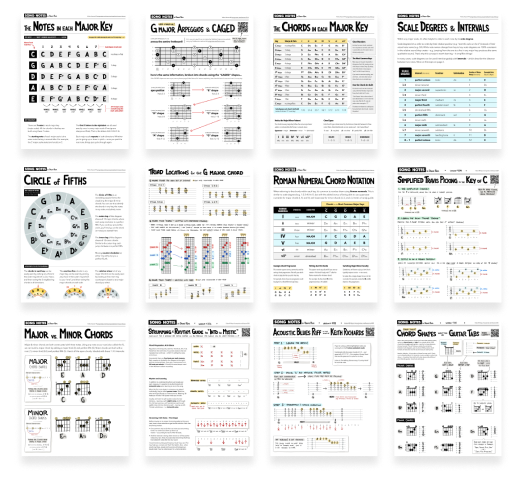CAGED Chord Shapes, Explained
Lesson #385 • Aug 25, 2021
Video lesson
Instructional PDF 1 page
Editor’s notes
My friends! New lesson here, where I finally dive into the CAGED system on guitar – AKA the pattern of major chord shapes that repeats on the fretboard, no matter which key you’re in. To be honest: this is a concept I’ve ignored diving into, thinking I had it all under control. That was 80% true -– but I did indeed have a few blind spots I’m glad I uncovered in the past week (specifically when it comes to the names we give each shape). So buckle up, and let’s dive in!
The one-pager PDF I made is a great starting point for visualizing the whole thing – showing both the fretboard major-chord pattern and how it repeats, as well as detailing each individual shape within the CAGED system.
I also recommend using my free FretMonster web tool to visualize things. I recommend setting Note Labels to “Scale Degree” instead of “Note Name” to help you see the pattern.
Video timestamps:
- 0:00 The Fretboard Pattern, At A Glance
- 1:50 Example: CAGED in Key of C
- 5:28 How the CAGED Shapes Get Their Name
- 10:35 Example: CAGED in Key of G
- 13:15 Additional Tips & Advice
- 17:50 How the Shapes Connect
Key Takeaways about CAGED Chord Shapes
What is “CAGED”?
CAGED refers to a pattern of 5 repeating shapes on the fretboard, named after the 5 open chords that use each shape.
How do the CAGED shapes get their name?
The shape names (C, A, G, E, and D) are defined by “the fingers you push down” when playing the open version of each chord. It’s also helpful to pay attention to the lowest-in-pitch root note used in the open chords (e.g. the 4th string for the open D-major chord; the 5th string for the open A-major chord; etc). In those two shapes, you continue to use those same strings for the lowest root note – even as you move the shape up the fretboard.
The CAGED shapes repeat!
The shapes repeat in both directions, in this exact order – no matter which shape you start with.
CAGED shapes apply to all major keys
You can play every major chord (all 12 of them) using each of these 5 shapes. e.g. A major can be played with the E shape. This is vital to understand… as CAGED isn’t something that only applies to some keys, but not others.
Why does CAGED start with C?
The “C” starting point in CAGED is 100% arbitrary, and likely exists because “caged” is an English word (which makes it memorable). The same concept would work if you started on any other letter – e.g. GEDCA or DCAGE, etc.
The shapes connect with each other!
All the shapes connect! The end of each shape is used in the start of the next shape (and the same going in reverse). A clear example of this the “three in a row” notes used in the A shape (just like you push down when doing an A-major chord), which are notes left open in the G-chape chord. Likewise, the thinnest-three-string “triangle” is visible in both the D-shape and the C-shape. Again, it’s the different bass-most root notes which set these shapes apart (e.g. D-shape’s lowest root is the 4th string; C-shape’s lowest root note is the 5th string).
Scale Intervals, 1-3-5, and “R” for Root Note
There are 7 intervals in the major scale, which repeat in both directions. “R” in my diagram refers to the root note, which is the same as the “1” interval. I recommend looking at things using intervals instead of notes, as the interval patterns stay 100% consistent within all musical keys (while the notes change). The major chord within any key is built using the intervals 1-3-5 within that key… which is helpful when visualizing CAGED on the fretboard.
Enjoy my lessons? Buy me a beer!
If this and my other lessons have proven helpful to you, please consider making a one-time donation to my tip jar. Contributions of any amount help make this project possible (including the many, many hours I put into it).
Fun & Helpful Tools I've Made
Subscribe to my YouTube channel
Be sure to never miss a lesson by subscribing on YouTube. I put out 2-3 new videos every week. These include full song lessons, as well as covers, practice tips, behind-the-scenes updates. Thanks!
Recent Lessons
-
April 9, 2024
Chords & Music Theory... 9 New Lessons!
-
March 30, 2024
Gordon Lightfoot's "Carefree Highway"
-
March 22, 2024
Lead Guitar & the F1 Theme Song
-
March 15, 2023
Pink Floyd's "Breathe" - with Simpler Chords Included
-
March 6, 2024
Q&A: 8 Tips to Avoid Muting Strings
-
March 1, 2024
Blues Shuffle Riffs - Using Just 2 Strings!
-
February 16, 2024
Soulful Lead Guitar with "America the Beautiful"
-
February 8, 2024
Country Honk by The Rolling Stones
-
January 31, 2024
Beginner Blues - New Course Sneak Peek!
-
January 23, 2024
Strumming with Accented Notes


